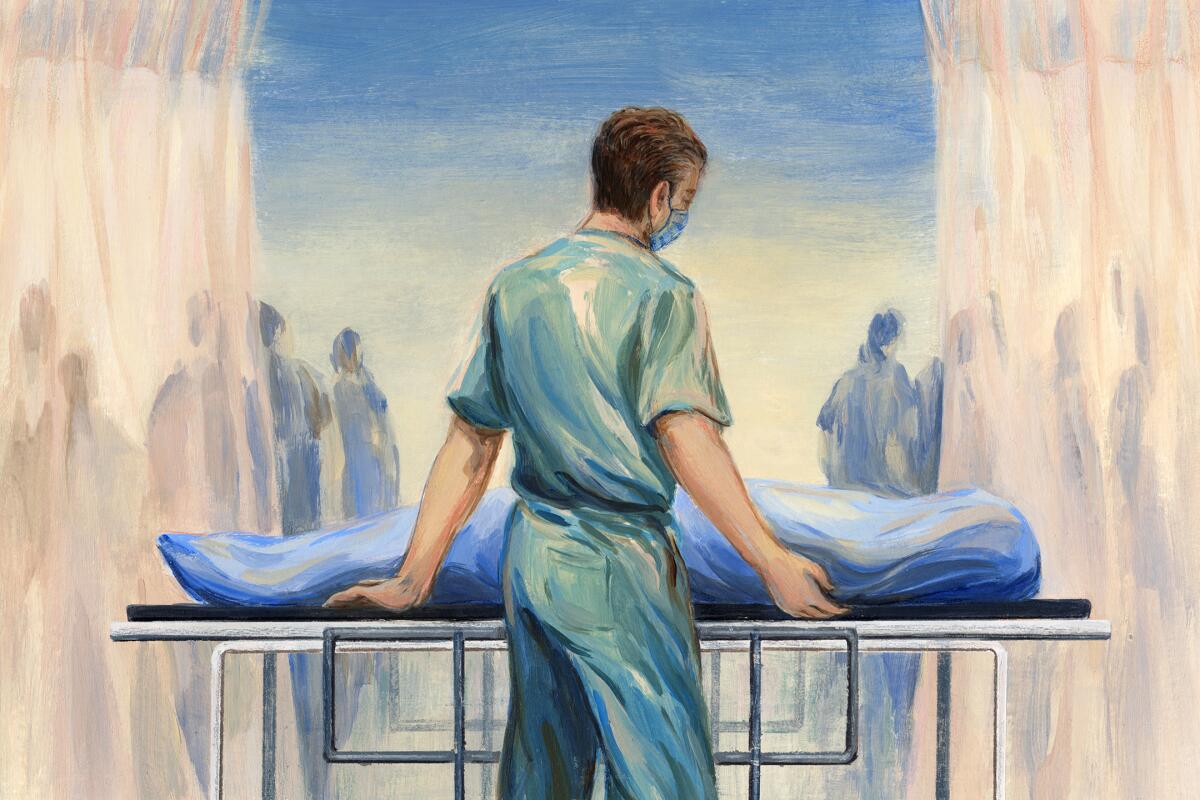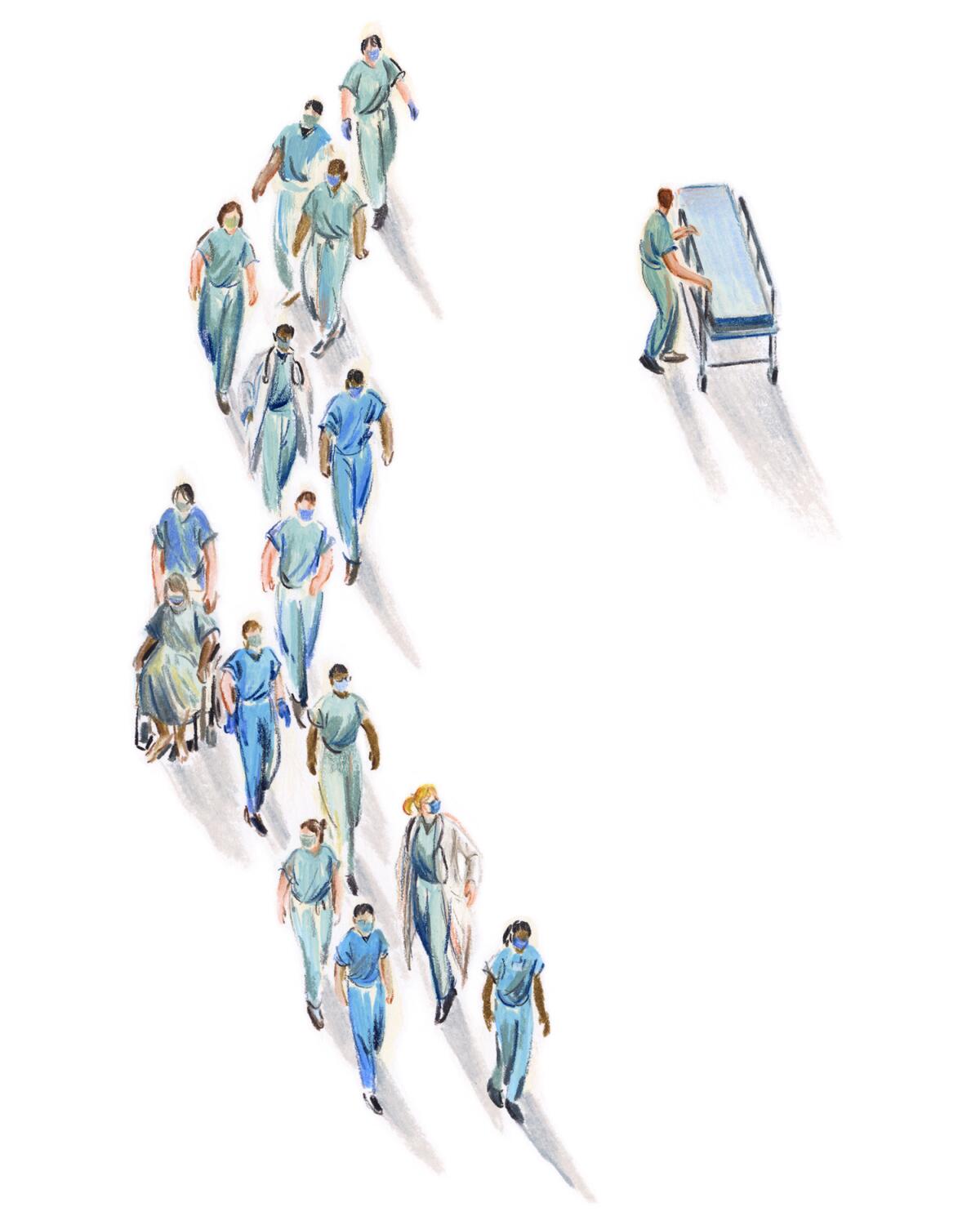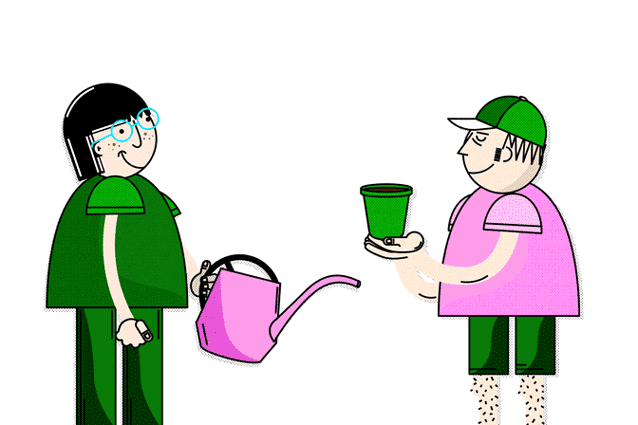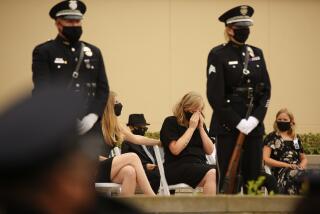It wasn’t just anyone who collected the bodies of the hospital’s COVID victims. It was Karl

- Share via
The winter surge of COVID-19 cases had — finally — begun to slow. Intensive care units across California were beginning to recover from unprecedented levels of disease and death. Hospital morgues were no longer quite so full.
And yet.
Dr. Courtney Martin lay in bed in her Redlands home, eyes wide open. The kids were safely tucked in down the hall. Her husband, Scott, snoozed quietly beside her. But sleep was a long way off for the 39-year-old obstetrician.
She reached for her iPhone in the darkness. Opened the notes app to an empty screen. And began to write.
I want to write about Karl. This is a long essay, but it’s because I love to write. Perhaps it’s my therapy, and perhaps it’s because Karl deserves to be noticed. Every hospital has a Karl.
Martin is the head of maternity services at Loma Linda University Medical Center, an accomplished physician and surgeon, a dynamic presence, 6 feet 1 inch tall, bright blond hair, ready smile.
Karl is an all-but-invisible man. He works in the massive medical center’s dispatch department, wheeling patients from hospital rooms to radiology for MRIs and CT scans. He delivers specimens to labs, moves supplies and medications, transports blood and plasma.
He has held the same job for the past 16 years. He is tall and thin, with curly reddish hair and a sprinkling of freckles across his nose. He wears teal scrubs, the dispatch department uniform. He is 45 years old. He does not like attention.
Martin, however, wants the world to know who Karl is and what he does. She calls him “this healthcare hero.”
Due to the pandemic, Karl became the person who moved the dead bodies from the rooms, then took them to the morgue. Maybe this was a job before the pandemic — I’m not sure. And, on the surface, this doesn’t seem that bad. But in a pandemic, Karl became the body collector.
::
The medical center where Karl spends his days has an adult hospital with 343 beds and a children’s hospital with 371. More than 3,500 babies are born there each year. It is the Inland Empire’s only Level I trauma center.
Under normal circumstances, the adult hospital’s seventh floor is home to the cardiac intensive care unit, where the sickest heart patients are treated. The morgue is an elevator ride away. Hospital officials will not say what floor it is on for “security reasons.”
During the winter surge, the cardiac ICU was transformed into a COVID ICU to handle the new crush of catastrophically ill men and women. The morgue just wasn’t big enough to hold all the pandemic dead, so the hospital brought in refrigerated trucks and parked them about a mile away on the sprawling university campus.
Karl has worked at the medical center since he was 29 years old. Before that, he had a factory job in Tucson. These days he lives in San Bernardino, describing himself in one sentence: “I’m just a regular guy who loves life, I love people.”
Karl is a Christian, a deeply private man of very few words. He does not want his last named used or his photograph taken. He was willing to answer questions about himself, his work and the pandemic’s impact — but only via email.
Q: Before the pandemic, what was a normal work day like for you?
A: “Similar to now however with many less deceased patients.”
Q: How did the pandemic change your job?
A: “Many, many more deaths, many more broken hearts, tears and pain.”
Q: How did the pandemic affect you?
A: “Saddened seeing much sadness due to deaths of loved ones.”
Q: What gives you satisfaction about your work?
A: “I just love being a helper and to serve others wherever I am.”
Q: How did you manage personally with the difficult changes the pandemic caused?
A: “By being respectful and understanding with patients, with hospital staff and with families whether visiting loved ones or seeing them pass. Also mindful of everyone whether in pain or gladness, i.e., rejoice with those who are happy and identify with those in pain.”
::
The coronavirus changed Martin’s job too, in ways she never could have imagined.
During the summer surge of 2020, she delivered the hospital’s first two babies whose mothers had advanced COVID-19. The women gave birth while in medically induced comas, hooked up to ventilators, touch and go.
They lived, and so did their premature daughters, Emiliana and Jade.
Martin said she loves working with pregnant women, bringing new life into the world. But during the pandemic’s winter surge, when the state’s healthcare system was strained to near breaking, she also began to help care for Loma Linda’s sickest COVID patients on a regular basis.
She does not remember exactly how many COVID patients she treated who did not survive those dark winter weeks. She would see them during morning rounds, and not long after, “they would die. Or we would withdraw care. Probably like 10 at least. It was a lot. It was terrible.”
That’s when her path crossed repeatedly with Karl’s — when the hospital was in such dire straits that obstetricians were treating men and body collectors were a regular presence in the intensive care unit.
Whenever I saw Karl, he had a lightness to him, always with a smile, soft eyes with small wrinkles and crow’s feet, and an unassuming approach. He had a way of seamlessly sliding on and off the unit with his morgue transport operation, while everyone else was hustling around ...
The phones were ringing, pagers going off, doors opening and closing, IV pumps beeping, ventilators oscillating, and then there was Karl, with a respectful smile, just quietly and efficiently moving bodies onto a metal gurney, and then covering them with a black tarp.
::
On one of the worst days of the winter surge—when thousands of Californians were coming down with the coronavirus and hundreds were dying each day — four patients on Loma Linda’s COVID intensive care unit died at about the same time.
Karl rolled a metal gurney onto the seventh floor to transport one of the bodies to the morgue. It was around midday, and the circular hallway that surrounds the nursing station was filled with people talking.
He couldn’t get through the crowd of doctors and nurses, respiratory techs and medical students. Man and gurney were pinned, Martin wrote, by equipment, walls and the medical team.
Dr. Courtney Martin is medical director for maternity services at Loma Linda University Children’s Hospital. During the pandemic, she split her time between maternity COVID patients and an overflow COVID-19 ward.
So he waited. Then he performed what Martin called “a miraculous maneuver,” sliding the bulky metal gurney into the dead patient’s room.
Martin had come over to the seventh floor from the maternity ward in the children’s hospital to check on two of her own struggling patients.
As she watched from afar, she realized that no one had looked up. Or said hello to Karl. Or moved to let him get on with his somber job. It was an “eerie” scene, she wrote, and gave her “a sense of loneliness for Karl and the others who transport the dead.”
Did they really not see him, or was it that it was too painful to keep acknowledging and saying hi to a sign that we didn’t save yet another father, mother, grandpa, grandma, or friend?
In that few hours, I’m pretty sure Karl collected all the dead and took them each to the morgue, which at this point was on refrigerated semi-trucks. I can’t imagine how he stacked them into the truck, or transferred them off the metal bed.
That day was filled with a lot of grief by the unit staff, nurses, residents, doctors — but what about dispatch? What about Karl?

::
Martin doesn’t remember exactly what kept her from sleeping on the February night when she lay in the dark and wrote about Karl.
Maybe, she said, she’d finally seen so much death and suffering that she could no longer compartmentalize the pain.
Maybe, she said, she was still furious about former President Trump’s campaign trail lies that caromed around social media, like the one from an October rally in Michigan. “Our doctors get more money if somebody dies from COVID,” he said at the time. “You know that, right?”
Or maybe she was haunted by the winter night she stood, frozen, outside a hospital room on the seventh floor COVID ICU wondering if she could possibly save the people inside.
The four people.
Two women and the premature babies they carried. Both women were on ventilators. Both were failing fast at the same time. Both babies were struggling.
“I’ll always remember being there outside the door just hearing the fetal heartbeats on all the monitors.” She knocks on the table, sharp fast raps. “And just having this, like, paralyzing moment of like, ‘Oh, my God, I’m feeling the stress.’”
She delivered one baby by emergency caesarean section. The mother, eventually, recovered from the virus. The other woman went home, on the mend, pregnant and planning to have her baby at her local hospital in Corona.
These, she said, “are the things that keep me up.”
::
About a week before that sleepless night, Martin ran into Karl on the labor and delivery unit. It was quiet, and he was taking a patient to have an ultrasound.
She asked him how he was doing, now that the pandemic was starting to abate. She wanted to know how he had managed the difficult winter weeks, realizing that he would come to work and spend most of his time transporting the dead.
She wanted to thank him.
When he answered her questions, she wrote, “I almost lost it.”
He said he was kept going during all of it because he felt like, when all the dust settled, the monitors were turned off, the family left, the sheet pulled over the face of a former life, that someone needed to make sure they still got care.
Someone needed to make sure they were put on the metal gurney nicely, arms positioned comfortably, feet and legs covered.
Someone needed to take them down to the morgue with dignity and care. Someone needed to escort them, go with them.
Someone needed to be their guardian.
No, not someone.
Karl.
More to Read
Sign up for Essential California
The most important California stories and recommendations in your inbox every morning.
You may occasionally receive promotional content from the Los Angeles Times.










